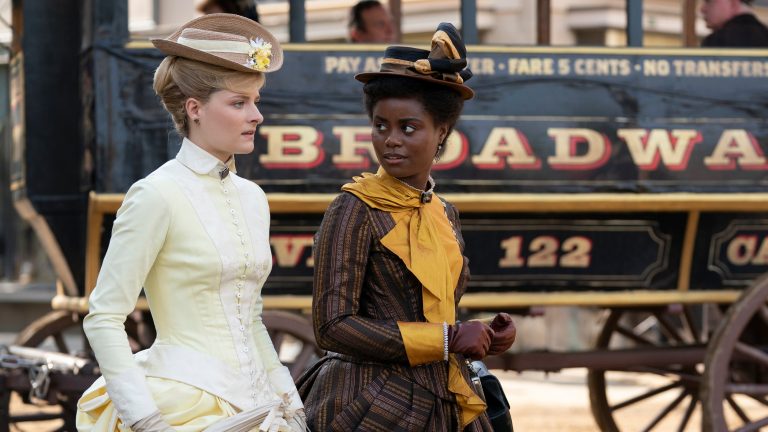The Gilded Age Episode 1 Review: Never the New
The Gilded Age delivers a rich mix of social drama and historical recreation in its 90-minute premiere.

This The Gilded Age review contains spoilers for “Never the New.”
The Gilded Age‘s two-part premiere episode is 90 minutes of epic period drama world-building. In the new HBO series, creator Julian Fellowes melds many of the storytelling tropes and elements that made Downton Abbey a worldwide hit with a less explored decade in American history into a story that delivers on the social drama and historical recreation. Let’s talk about “Never the New, Parts 1 & 2.”
The Gilded Age Setting
The Gilded Age‘s setting is 1882 New York City, a city of rapid changes in both society and industry. Thousands of new residents arrive either from other places in America or from around the world. The Industrial Revolution created a new class of millionaires and billionaires to challenge the generational wealth of the oldest families. As these elites gained wealth, the gap between the richest and the poorest Americans increased exponentially. Mrs. Astor (Donna Murphy) and her friend Ward McAllister (Nathan Lane, who doesn’t appear in opening 90 minutes) famously kept a list called The Four Hundred the wealthiest and most influential New Yorkers—a context for everything that happens in the new HBO series, even when it isn’t explicitly mentioned.
The Gilded Age Characters
A 90-minute episode is an unusual time format for a non crime/procedural period drama, yet the episode manages to introduce all of the most important characters and a few supporting cast members in a cohesive fashion.
George Russell (Morgan Spector) is a railroad company owner who wants to grow his business and his influence. His wife, Bertha (Carrie Coon), is tired of her old upper middle class friends. They build and move into a new house in the fashionable part of Fifth Avenue as Bertha is determined to be accepted as part of the highest echelons of society. Bertha also hopes her children Larry (Harry Richardson) and Gladys (Taissa Farmiga) may make some of the connections necessary to join the Four Hundred.
Across the street from the Russells are two representatives of the old money elites. Ada Brook (Cynthia Nixon) and Agnes Van Rijin (Christine Baranski), often referred to as ”the Aunts,” are sisters whose family tree goes back to the days of Dutch control of the city. Agnes’ son Oscar (Blake Ritson) has a very busy social calendar and isn’t always home. Ada and Agnes are definitely not in favor of Bertha’s plans to infiltrate their social circle.
Marian Brook (Louisa Jacobson) has to move in with her aunts Agnes and Ada after her fathers’ death. Adjusting to a new life depending on their financial generosity and the social norms of the elite is difficult. On the platform waiting for the train that will take her to the city she meets Peggy Scott (Denée Benton), a young Black woman who is also traveling to the city for a fresh start. She wants to be a writer but first needs to find work to pay the rent in the meantime.
Both the aunts and the Russells employ servants to cook, clean and serve. Some view their jobs as just a way to pay the rent while others want to move up in the world. These scenes in the kitchen and servants quarters are not just for sharing gossip. These workers are at the core of the scoial inequality that existed in the 1880’s.
The Gilded Age Story
Bertha’s attempt to show off the new house and ingratiate herself with society, along with Marian adjusting to living with her previously estranged aunts, forms the bulk of the episodes’ action. Peggy’s new job as a secretary to a wealthy white woman places her on a trajectory where she has to balance the world she comes from while navigating a space where there is sure to be racial and sexist hostility. These are the plotlines sure to drive the engine of drama in future episodes.
The comparisons between the Crawleys and the Russells are inevitable especially as Fellowes initially pitched The Gilded Age to networks as Robert and Cora Crawley’s backstory during this era. However, many of these comparisons are predicated on the notion that similarities are either bad or unoriginal. Reusing tropes and having a signature style of storytelling is not always a bad thing. First of all, period drama as a genre thrives on adapting many of the same stories with subtle or bold changes each time. Upstairs, Downstairs (both the 1970’s series and the 2010 sequel series) was the period drama that established the dynamic of exploring both the elite classes and the lives of their servants simultaneously. Fellowes and other screenwriters have used that format since to flesh out new characters and shift that formula to different eras in time.
American author Edith Wharton is widely recognized as the first fictional chronicler of the Gilded Age. She was a debutante and used those experiences in her novels. The Age of Innocence, The House of Mirth, and others have been adapted into several films and theater productions over the years. Technically, Wharton’s characters should have been at the start of any speculation regarding what an “American Downton Abbey” would look like.
The rivalry between Bertha and the women of high society gives The Gilded Age a much more aggressive and more obvious soap opera vibe. The Russells aren’t motivated by upholding tradition or saving the family. They want to gain power and influence and upend tradition along the way. Social drama and conflict are at the heart of what the term soap opera really means instead of the pejorative against “low quality” episodic TV it is usually applied to. Not only did Downton Abbey blend in at times over the top social conflicts into the story, but period dramas and soap operas also use the same storytelling tropes.
Peggy and Oscar’s storylines are a massive improvement on what has come before as both represent marginalized groups that have never or very rarely been featured in previous period productions featuring American elites in the 1880’s.
No previous Wharton adaptation or biopic based on the real figures of the era ever turned their eyes towards the lives of African Americans during this era. The majority of previous American period dramas center on the trauma of slavery and/or the Civil War and then ignore the 1870’s to 1910’s. Peggy’s storyline clearly reflects Fellowes taking to heart some of the critiques of Downton Abbey failing to do justice to Black British history. The Gilded Age’s chief historical adviser Dr. Erica Dunbar specializes in 19th Century African-American History. It’s fair to wonder why the entire series isn’t focused on Peggy. At the same time, this is only the beginning of her story, so it is too soon to tell if her journey is tokenized or given full weight compared to Marian and others. Her presence opens up opportunities for future BIPOC screenwriters to write biopics or fictional dramas set in this era.
The reveal that Oscar Van Rijin is queer is also adding something not seen before in American period dramas set in this era as well. Just because previous dramas didn’t feature queer characters does not mean queer people didn’t exist in 1880s America. America is important to note here as Fingersmith, Tipping the Velvet, and Miss Scarlet and The Duke all have queer main or supporting characters living in late Victorian England. Oscar’s character trajectory could go in many directions and it’s also too soon to criticize his plot for perpetuating negative stereotypes and tropes. Queer critics of Thomas Barrow’s storyline on Downton Abbey must keep in mind Oscar is facing a different class and cultural dynamic which would affect his experience of queerphobia Like Peggy, Oscar’s plotline can set up future queer screenwriters to portray American queer lives a century before Stonewall.
Overall, The Gilded Age premiere delivers to American period drama fans a rich mix of social drama and historical recreation. There are a lot of characters to keep track of, but audiences are rewarded for their time with a story guaranteed to distract from the ongoing pandemic.
